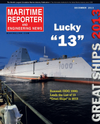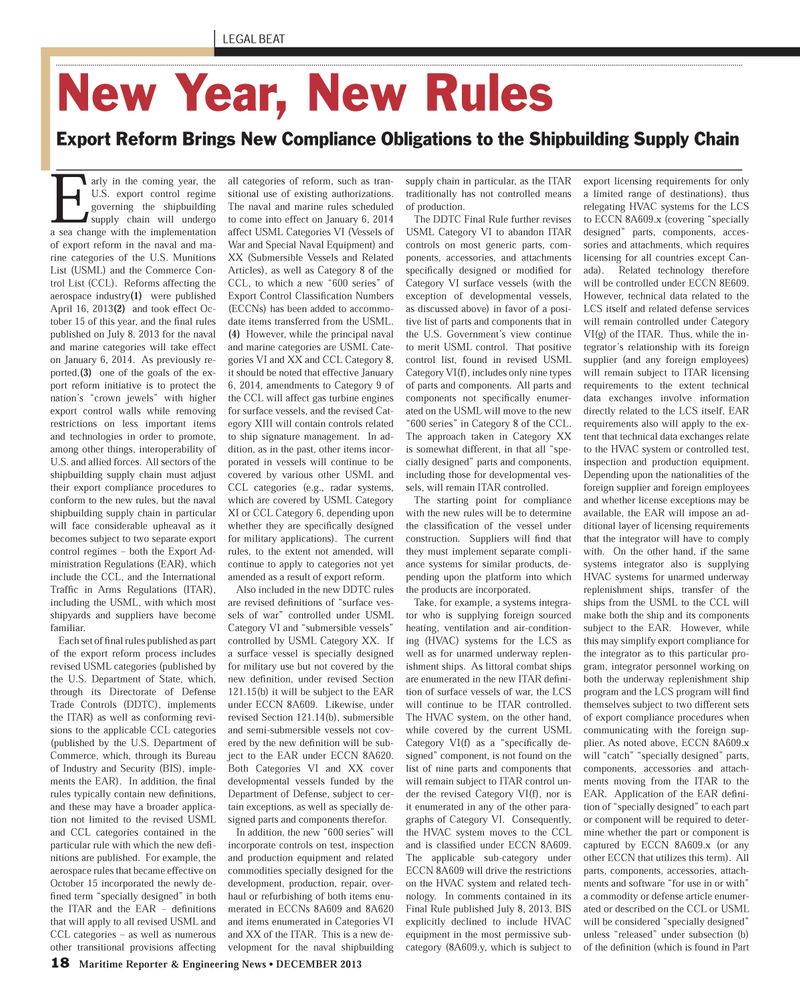
Page 18: of Maritime Reporter Magazine (December 2013)
Great Ships of 2013
Read this page in Pdf, Flash or Html5 edition of December 2013 Maritime Reporter Magazine
18 Maritime Reporter & Engineering News ? DECEMBER 2013 Early in the coming year, the U.S. export control regime governing the shipbuilding supply chain will undergo a sea change with the implementation of export reform in the naval and ma-rine categories of the U.S. Munitions List (USML) and the Commerce Con-trol List (CCL). Reforms affecting the aerospace industry(1) were published April 16, 2013(2) and took effect Oc- tober 15 of this year, and the Þ nal rules published on July 8, 2013 for the naval and marine categories will take effect on January 6, 2014. As previously re- ported,(3) one of the goals of the ex-port reform initiative is to protect the nation?s ?crown jewels? with higher export control walls while removing restrictions on less important items and technologies in order to promote, among other things, interoperability of U.S. and allied forces. All sectors of the shipbuilding supply chain must adjust their export compliance procedures to conform to the new rules, but the naval shipbuilding supply chain in particular will face considerable upheaval as it becomes subject to two separate export control regimes ? both the Export Ad- ministration Regulations (EAR), which include the CCL, and the International Traf Þ c in Arms Regulations (ITAR), including the USML, with which most shipyards and suppliers have become familiar. Each set of Þ nal rules published as part of the export reform process includes revised USML categories (published by the U.S. Department of State, which, through its Directorate of Defense Trade Controls (DDTC), implements the ITAR) as well as conforming revi- sions to the applicable CCL categories (published by the U.S. Department of Commerce, which, through its Bureau of Industry and Security (BIS), imple-ments the EAR). In addition, the Þ nal rules typically contain new deÞ nitions, and these may have a broader applica-tion not limited to the revised USML and CCL categories contained in the particular rule with which the new deÞ -nitions are published. For example, the aerospace rules that became effective on October 15 incorporated the newly de-Þ ned term ?specially designed? in both the ITAR and the EAR ? de Þ nitions that will apply to all revised USML and CCL categories ? as well as numerous other transitional provisions affecting all categories of reform, such as tran-sitional use of existing authorizations. The naval and marine rules scheduled to come into effect on January 6, 2014 affect USML Categories VI (Vessels of War and Special Naval Equipment) and XX (Submersible Vessels and Related Articles), as well as Category 8 of the CCL, to which a new ?600 series? of Export Control ClassiÞ cation Numbers (ECCNs) has been added to accommo-date items transferred from the USML.(4) However, while the principal naval and marine categories are USML Cate- gories VI and XX and CCL Category 8, it should be noted that effective January 6, 2014, amendments to Category 9 of the CCL will affect gas turbine engines for surface vessels, and the revised Cat-egory XIII will contain controls related to ship signature management. In ad-dition, as in the past, other items incor- porated in vessels will continue to be covered by various other USML and CCL categories (e.g., radar systems, which are covered by USML Category XI or CCL Category 6, depending upon whether they are speciÞ cally designed for military applications). The current rules, to the extent not amended, will continue to apply to categories not yet amended as a result of export reform.Also included in the new DDTC rules are revised deÞ nitions of ?surface ves- sels of war? controlled under USML Category VI and ?submersible vessels? controlled by USML Category XX. If a surface vessel is specially designed for military use but not covered by the new deÞ nition, under revised Section 121.15(b) it will be subject to the EAR under ECCN 8A609. Likewise, under revised Section 121.14(b), submersible and semi-submersible vessels not cov-ered by the new deÞ nition will be sub- ject to the EAR under ECCN 8A620. Both Categories VI and XX cover developmental vessels funded by the Department of Defense, subject to cer- tain exceptions, as well as specially de-signed parts and components therefor. In addition, the new ?600 series? will incorporate controls on test, inspection and production equipment and related commodities specially designed for the development, production, repair, over- haul or refurbishing of both items enu-merated in ECCNs 8A609 and 8A620 and items enumerated in Categories VI and XX of the ITAR. This is a new de- velopment for the naval shipbuilding supply chain in particular, as the ITAR traditionally has not controlled means of production.The DDTC Final Rule further revises USML Category VI to abandon ITAR controls on most generic parts, com-ponents, accessories, and attachments speciÞ cally designed or modi Þ ed for Category VI surface vessels (with the exception of developmental vessels, as discussed above) in favor of a posi-tive list of parts and components that in the U.S. Government?s view continue to merit USML control. That positive control list, found in revised USML Category VI(f), includes only nine types of parts and components. All parts and components not speciÞ cally enumer- ated on the USML will move to the new ?600 series? in Category 8 of the CCL. The approach taken in Category XX is somewhat different, in that all ?spe- cially designed? parts and components, including those for developmental ves-sels, will remain ITAR controlled. The starting point for compliance with the new rules will be to determine the classiÞ cation of the vessel under construction. Suppliers will Þ nd that they must implement separate compli-ance systems for similar products, de-pending upon the platform into which the products are incorporated.Take, for example, a systems integra- tor who is supplying foreign sourced heating, ventilation and air-condition- ing (HVAC) systems for the LCS as well as for unarmed underway replen-ishment ships. As littoral combat ships are enumerated in the new ITAR de Þ ni-tion of surface vessels of war, the LCS will continue to be ITAR controlled. The HVAC system, on the other hand, while covered by the current USML Category VI(f) as a ?speci Þ cally de- signed? component, is not found on the list of nine parts and components that will remain subject to ITAR control un- der the revised Category VI(f), nor is it enumerated in any of the other para-graphs of Category VI. Consequently, the HVAC system moves to the CCL and is classiÞ ed under ECCN 8A609. The applicable sub-category under ECCN 8A609 will drive the restrictions on the HVAC system and related tech- nology. In comments contained in its Final Rule published July 8, 2013, BIS explicitly declined to include HVAC equipment in the most permissive sub-category (8A609.y, which is subject to export licensing requirements for only a limited range of destinations), thus relegating HVAC systems for the LCS to ECCN 8A609.x (covering ?specially designed? parts, components, acces-sories and attachments, which requires licensing for all countries except Can-ada). Related technology therefore will be controlled under ECCN 8E609. However, technical data related to the LCS itself and related defense services will remain controlled under Category VI(g) of the ITAR. Thus, while the in- tegrator?s relationship with its foreign supplier (and any foreign employees) will remain subject to ITAR licensing requirements to the extent technical data exchanges involve information directly related to the LCS itself, EAR requirements also will apply to the ex-tent that technical data exchanges relate to the HVAC system or controlled test, inspection and production equipment. Depending upon the nationalities of the foreign supplier and foreign employees and whether license exceptions may be available, the EAR will impose an ad-ditional layer of licensing requirements that the integrator will have to comply with. On the other hand, if the same systems integrator also is supplying HVAC systems for unarmed underway replenishment ships, transfer of the ships from the USML to the CCL will make both the ship and its components subject to the EAR. However, while this may simplify export compliance for the integrator as to this particular pro-gram, integrator personnel working on both the underway replenishment ship program and the LCS program will Þ nd themselves subject to two different sets of export compliance procedures when communicating with the foreign sup-plier. As noted above, ECCN 8A609.x will ?catch? ?specially designed? parts, components, accessories and attach-ments moving from the ITAR to the EAR. Application of the EAR de Þ ni-tion of ?specially designed? to each part or component will be required to deter- mine whether the part or component is captured by ECCN 8A609.x (or any other ECCN that utilizes this term). All parts, components, accessories, attach-ments and software ?for use in or with? a commodity or defense article enumer- ated or described on the CCL or USML will be considered ?specially designed? unless ?released? under subsection (b) of the deÞ nition (which is found in Part LEGAL BEAT New Year, New Rules Export Reform Brings New Compliance Obligations to the Shipbuilding Supply ChainMR #12 (18-25).indd 18MR #12 (18-25).indd 1811/27/2013 2:39:27 PM11/27/2013 2:39:27 PM

 17
17

 19
19
